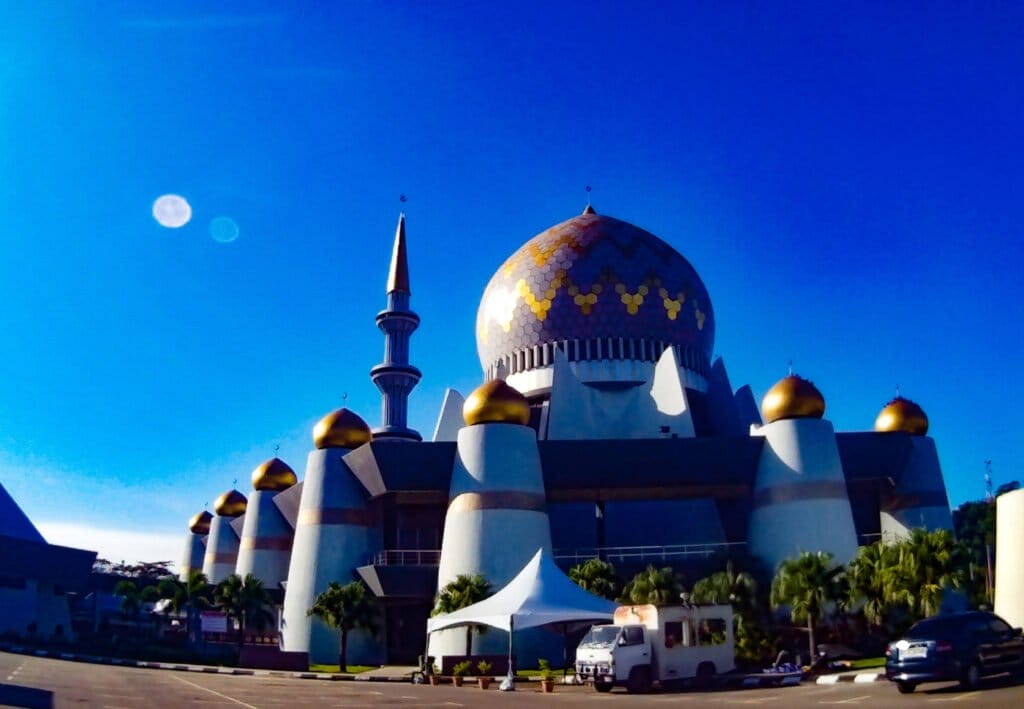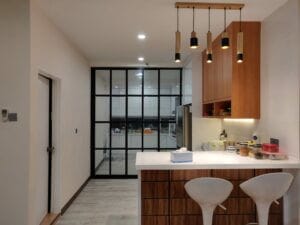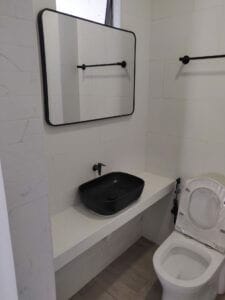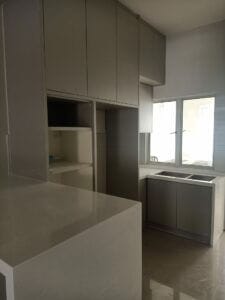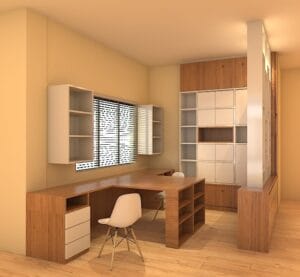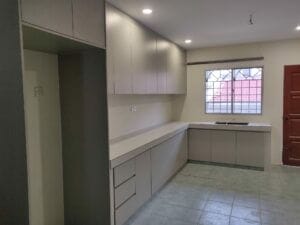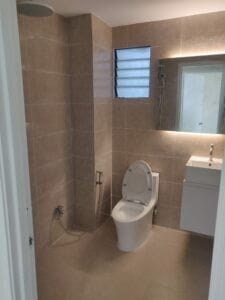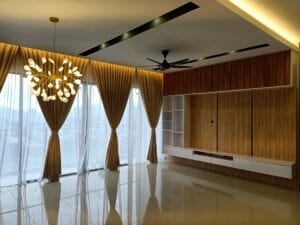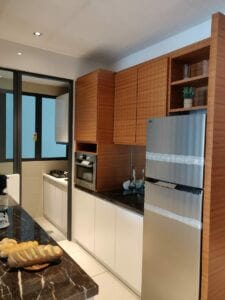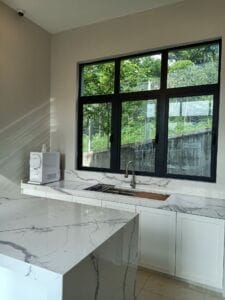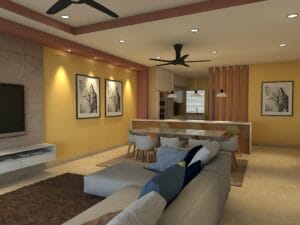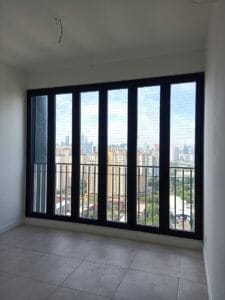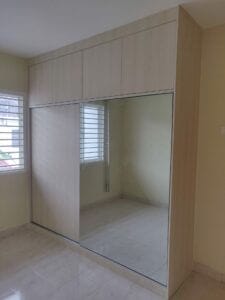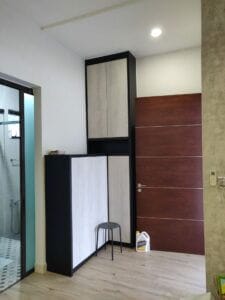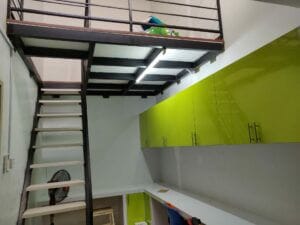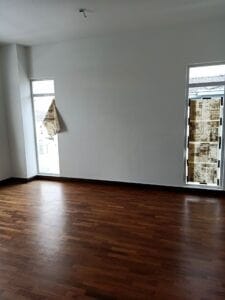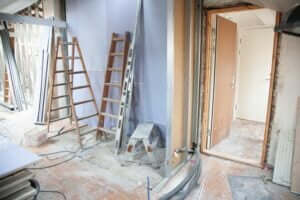10 MOSQUE ARCHITECTURE IN MALAYSIA
1. MASJID DIRAJA SULTAN SULAIMAN, SELANGOR
10 MOSQUE ARCHITECTURE IN MALAYSIA
Masjid Diraja Sultan Sulaiman was built in 1932. The design concept of the Masjid Diraja Sultan Sulaiman in Bandar Diraja Klang is quite different from any mosque in the state of Selangor or in Malaysia. Some say that the Masjid Diraja Sultan Sulaiman has the influence of a mixture of Moorish Islamic architecture and English architecture. Some say that the Masjid Diraja Sultan Sulaiman has an Art Deco concept because minimal decorative elements are used here. The use of simple geometry on mosque plans also leads to Art Deco.
There are still classical elements especially on the pillars, however they are quite minimal. The dome of the mosque is semi -circular (semi -hemispherical) egg -yellow (not golden). The large dome of the main prayer hall is surrounded by several smaller domes.
There are 8 small towers around the mosque and a large tall tower in the middle of the entrance from the main porch. The tower is also decorated with a yellow dome at the top. The current Masjid Diraja Sultan Sulaiman has already undergone several interior renovations and in the ‘courtyard’ area of the original building. The original design was like a cross when viewed from above, as is often used in church plans in Europe. But now the shape of the Masjid Diraja Sultan Sulaiman looks like a square as a result of renovations by the Selangor Islamic Religious Department.
The main prayer room of the Sultan Suleiman Royal Mosque is octagonal (octagonal) at the bottom and begins to turn into a round shape at a level of 10 meters. The inside of the main dome can be climbed as it has two levels like a balcony. The second level is accessible with a cat ladder. There is a layer of decorative iron frame under the dome used to support the ‘colour glasses’ arranged in a ‘pattern’.
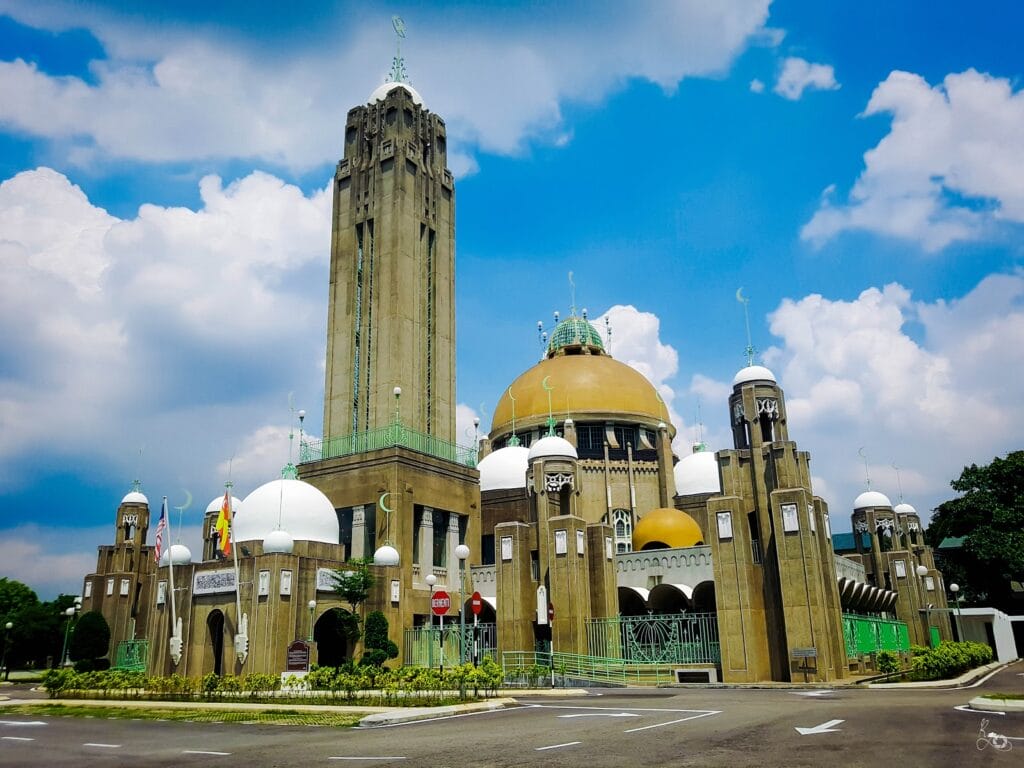
2. MASJID NEGARA, KUALA LUMPUR
10 MOSQUE ARCHITECTURE IN MALAYSIA
A mosque with its own identity & the largest in Southeast Asia at the time. The design is modern, decorated with Islamic patterns while there is an application of local architectural values. This rather unique modern design encompasses contemporary expression in the art of traditional Islamic calligraphy & ornaments.
Judging from the use of reinforced concrete on the entire structure of the mosque, it can be said that it symbolizes the strength & resilience of Malaysians after independence.
The shape of the top of the azan tower & the polished roof & the square of the main prayer hall symbolize loyalty, matched from the shape of the royal umbrella. The tower gives the impression of a closed umbrella while the roof is in the form of an open umbrella.
This mosque took 2 years to complete, from 1963 to 1965 and cost 10 million ringgit.
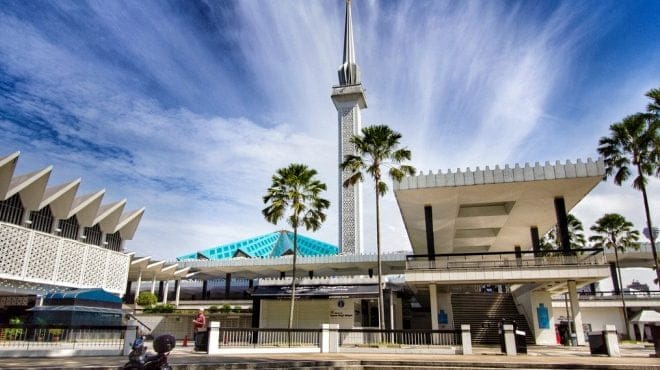
3. MASJID JAMEK, KUALA LUMPUR
10 MOSQUE ARCHITECTURE IN MALAYSIA
The design of the mosque follows the traditional layout of North India, with the prayer hall opening towards the enclosed courtyard or “sahn”. The mosque is flanked by two towers and several smaller towers. The dome of onions at the top of the prayer hall and at the top of the tower resembles Moghul architecture.
The Masjid Jamek is an example of “official” British architecture in Malaysia, which involves a combination of Moorish and Mughal elements. The red and white stripes of the stone walls similar to those of the Jamek Mosque in Cordoba, Spain, form the outer walls of the mosque. Other similarities with Moorish mosques can be seen on the pillared arches in the form of compartments and details with intervals of strips of brick, plaster and marble.
The British administrators were the ones who started bringing domes in buildings in Malaysia. Their source of inspiration was the Moghul buildings in India. Then came the domed mosque at Ubudiah Mosque in Kuala Kangsar, Zahir Alor Star Mosque and Masjid Jamek in Kuala Lumpur. The highlights are the Sultan Abdul Samad Building, the KTM headquarters building and the Kuala Lumpur Railway Station

4. MASJID KAMPUNG LAUT, KELANTAN
10 MOSQUE ARCHITECTURE IN MALAYSIA
This mosque is built with elements of archipelago architecture. It is a basic structure with only four pillars supporting a three -story roof made of thatch leaves. Its area is only 400 square feet. By the end of the 19th century, the mosque became an important religious centre, and the mosque was enlarged to include additional prayer rooms, roles, foyers, and towers. 20 pillars were built to support this additional construction. This additional construction uses a very unique ‘Tebuk-Pasak’ technique. It is built of wood but does not use even a single nail. The thatched roof was converted to a tiled roof because the tiled roof was stronger than the thatched roof.
In 1988, the mosque was further improved with modern facilities such as electricity, running water, toilets and seating areas. The pillars and walls of the mosque are also decorated with wood carvings.
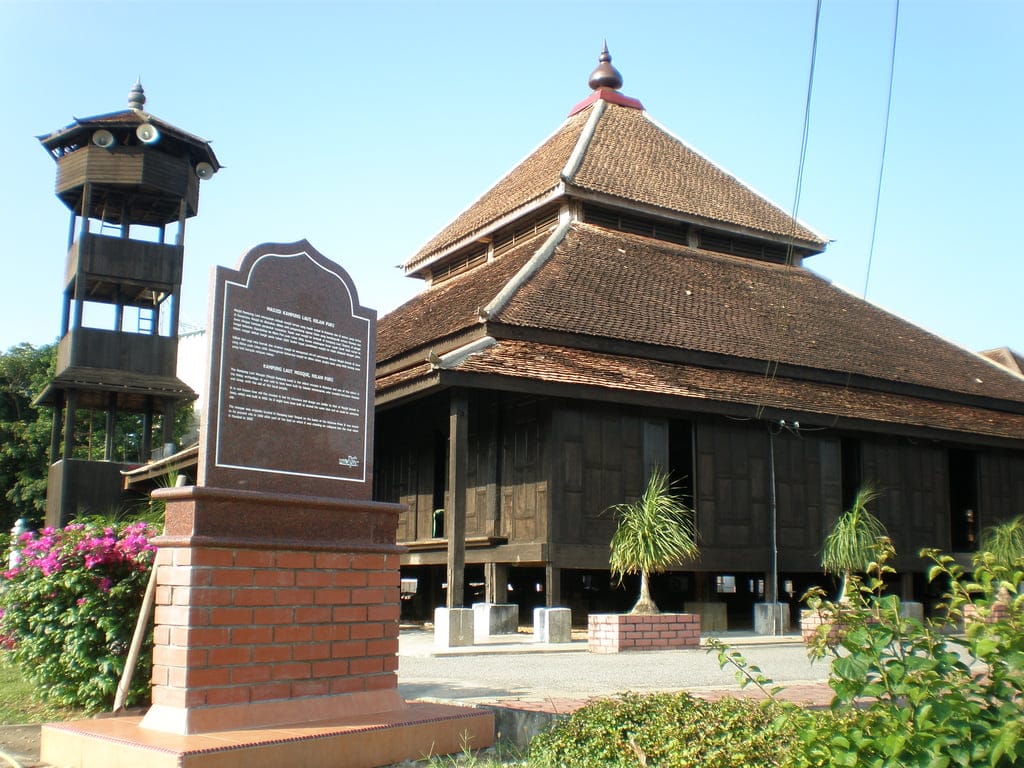
5. MASJID TRANQUERAH, MELAKA
10 MOSQUE ARCHITECTURE IN MALAYSIA
In Melaka is not only rich in history but has several mosques that are charming and stand out. One of the oldest mosques in the state and the most in focus is the Masjid Tengkera located in Jalan Tengkera. Masjid Tengkera is one of the oldest mosques in Malaysia.
The original mosque structure is made entirely of wood purchased from Kalimantan, the Dutch East India Company. Since at that time, it has undergone some renovations also restorations. This mosque consists of Javanese cultural components. It has a three -story pyramid roof and a square base. This is one of the few mosques in Malaysia that has a pagoda instead of a tower. The interior is a mix of Malay, Chinese and Indonesian.
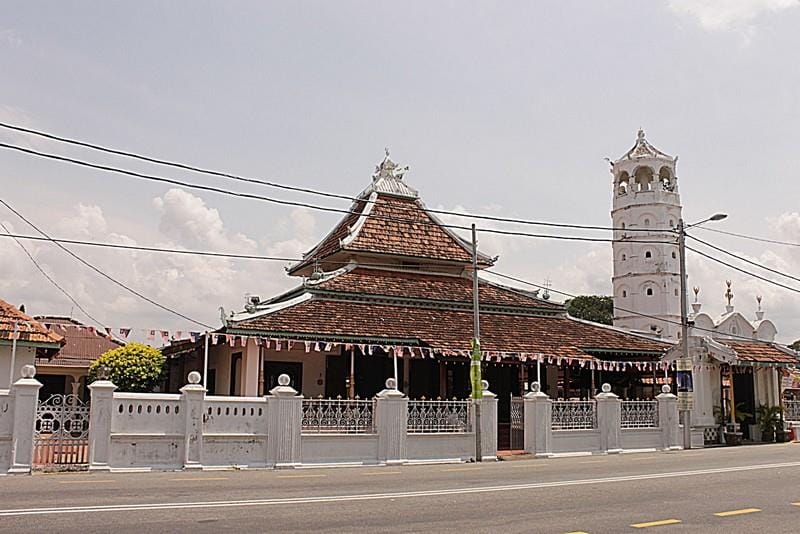
6. MASJID ZAHIR, KEDAH
10 MOSQUE ARCHITECTURE IN MALAYSIA
Masjid Zahir in Alor Setar is a famous mosque in Malaysia. This architecture is over a century old and is arguably one of the most beautiful mosques in the world. The architectural elements of the Masjid Zahir are heavily influenced by Mughal architecture originating from North India. However, this mosque is no longer a prestigious mosque because the renovation work is seen to interfere with the true identity of the mosque.
These mosques no longer display the uniqueness of their multi-foliar arches. We must appreciate the architectural history shown by the buildings that exist in our built environment. Even though our country has a much younger architectural history than other civilizations and we as a society fail to appreciate all this? Forever we will not have a great history.

7. MASJID PUTRA, PUTRAJAYA
10 MOSQUE ARCHITECTURE IN MALAYSIA
The Putra Mosque is a beautiful rose-coloured granite building that took two years to complete it. Construction influence of the Middle East also the Persian and Malay traditional architecture. The mosque was named in honour of Tunku Abdul Rahman Putra Al Haj, the first Prime Minister of Malaysia.
For specific details of this structure, the main dome of the Putra Mosque is 160 feet (50m) high with a tower as high as 381 feet (116m), making the tower of the Putra Mosque the third tallest in the world. That tower was inspired from the Sheikh Omar Mosque in Baghdad. Layered indentations are visible in both towers, although each has been done slightly differently. Menara Masjid Putra has five long floors with a modern and simple design.
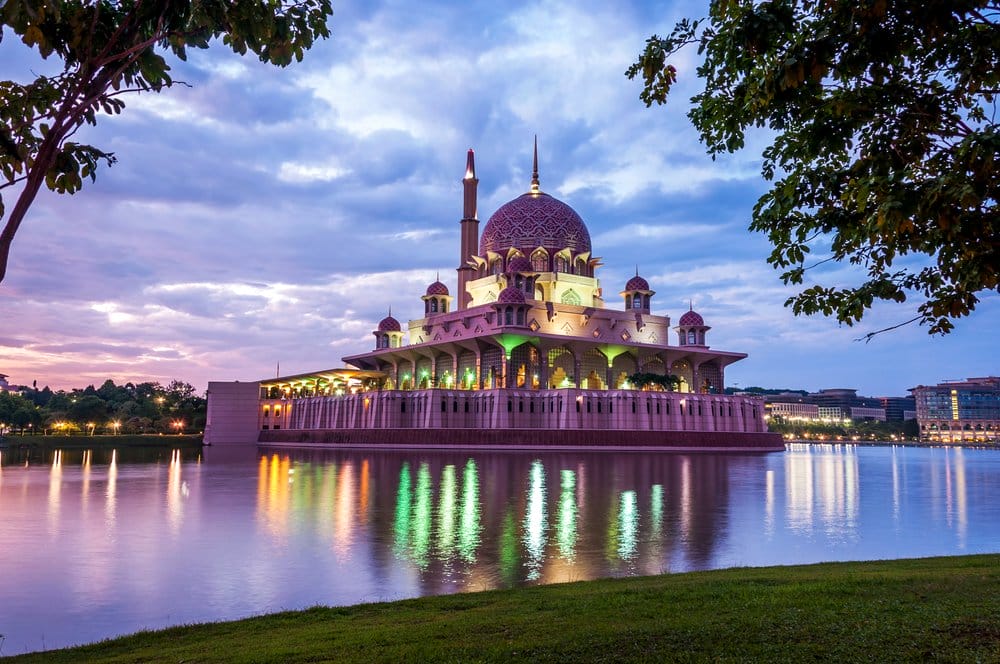
8. MASJID TENGKU TENGAH - FLOATING MOSQUE, TERENGGANU
10 MOSQUE ARCHITECTURE IN MALAYSIA
The floating mosque located in Kuala Ibai about 7 km from the city of Kuala Terengganu and near the beach area is the first floating mosque in Malaysia. The mosque features a combination of features of Islamic civilization and local architecture with the use of marble and ceramics. This floating mosque or Tengku Tengah Zaharah Mosque is named in conjunction with the name of the mother of the 17th Al-Marhum Sultan of Terengganu, the Almarhumah Tengku Tengah Zaharah, the late Tengku Setia Diraja Tengku Omar.
This mosque was built from the inspiration of the late Sultan of Terengganu, Al-Marhum Sultan Mahmud Al-Muktafi Billah Shah Ibni al-Marhum Sultan Ismail Nasiruddin Shah. The mosque has an area of 1,372 square meters and has a tower with a height of 38 meters.
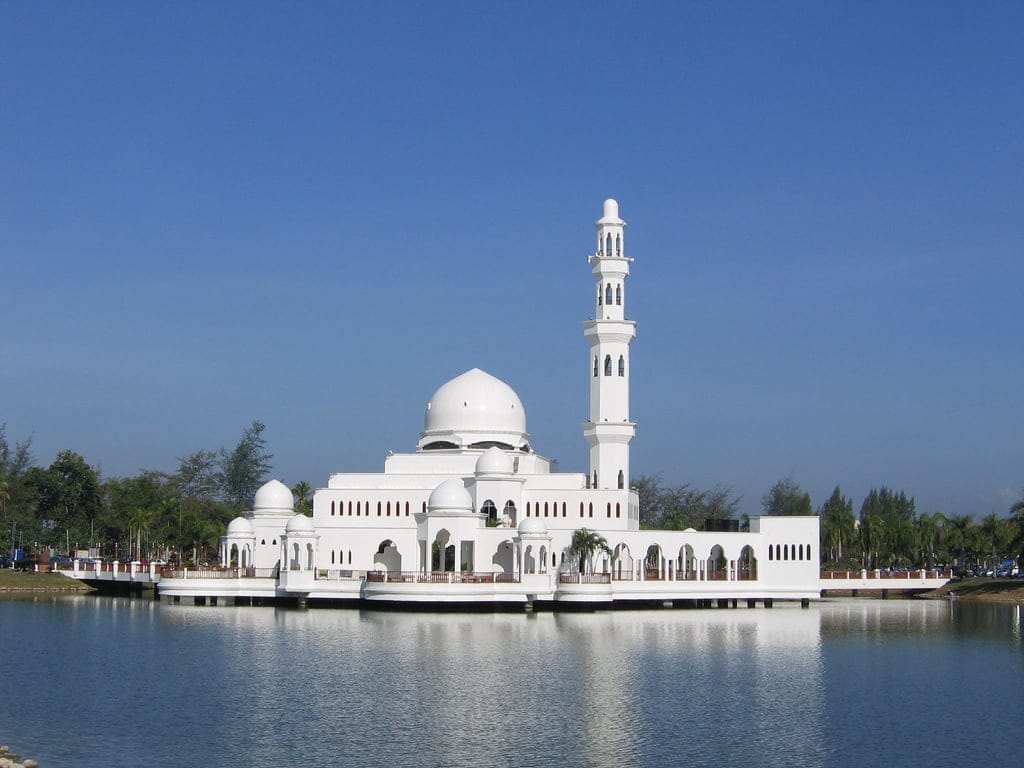
9. MASJID JAMEK, SARAWAK
10 MOSQUE ARCHITECTURE IN MALAYSIA
This mosque has the concept of a mosque design in Istanbul. The roof is rectangular. It is equipped with a main dome and forty small domes. The main dome is decorated with mosaics and tiles while the inside is a geometric -patterned openwork. The pillars that support the small domes look like the position of the hands while praying.
Colourful glass mirrors are an interesting decoration that can highlight the beauty of this mosque. The entire floor of the mosque uses a marble finish that can cool the atmosphere when inside.
A tower was erected separately from this mosque as a landmark. To meet the needs of the congregation to carry out activities, the mosque is equipped with basic facilities such as conference hall, library and office space for mosque staff.
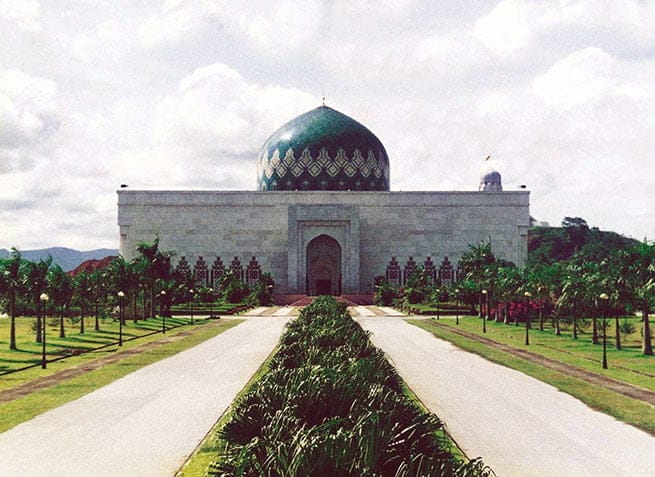
10. MASJID NEGERI, SABAH
10 MOSQUE ARCHITECTURE IN MALAYSIA
The design of the Sabah State Mosque created by the architect Jurubena Bertiga has its own concept. Although it was built and prepared with all modern equipment, but anyone who looks at it from outside the mosque, at a glance can describe the design is a combination of the greatness of Islam in the past with modern times.
The large dome located in the qibla of the mosque is an enduring tradition of Islamic greatness from the past, inspired by the great and famous old mosques in the world such as the Al-Aqsa Mosque in Baitul-Makdis, the famous Blue Mosque in Istanbul and the Mosque Jame in New Delhi and Lahore. Similarly, the 215-foot-tall tower was designed by the Grand Mosque in Mecca and the Prophet’s Mosque in Medina.
The introduction of this tradition reflects the desires and aspirations of Muslims to always abide by Islamic law in this age and the future will have to face and accept the challenges of life and the currents of this modern age. Meanwhile, the design and decoration of the mosque is part of strengthening the concept, Muslims who are in the prayer hall under the big dome will enjoy an atmosphere full of devotion and piety, not only because of observing the beauty of its decoration but also will realize how great the power of God, which is reflected from the whole scene around the interior of the mosque.
